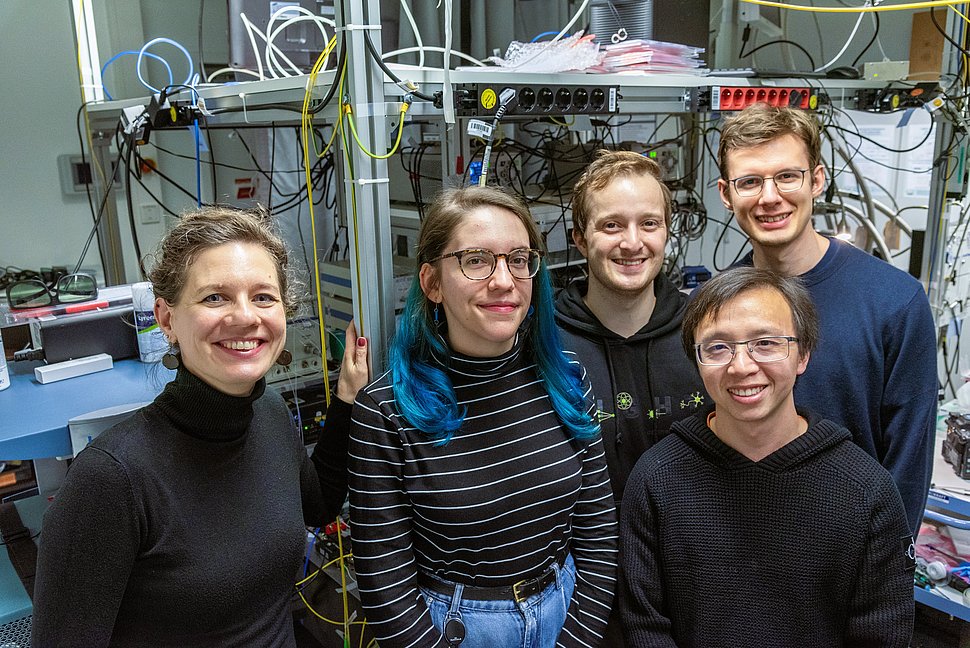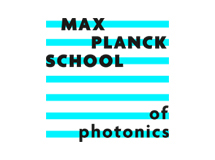Towards the quantum of sound
A team of scientists at the Max Planck Institute for the Science of Light led by Dr. Birgit Stiller has succeeded in cooling traveling sound waves in waveguides considerably further than has previously been possible using laser light. This achievement represents a significant move towards the ultimate goal of reaching the quantum ground state of sound in waveguides. Unwanted noise generated by the acoustic waves at room temperature can be eliminated. This experimental approach both provides a deeper understanding of the transition from classical to quantum phenomena of sound and is relevant to quantum communication systems and future quantum technologies.

Artist’s impression of cooled acoustic waves in an optical fiber taper (© Long Huy Dao)

Birgit Stiller's research team in the lab: Birgit Stiller, Laura Blázquez Martínez, Andreas Geilen, Changlong Zhu, Philipp Wiedemann (f.l.t.r.) © Florian Ritter, MPL
The quantum ground state of an acoustic wave of a certain frequency can be reached by completely cooling the system. In this way, the number of quantum particles, the so-called acoustic phonons, which cause disturbance to quantum measurements, can be reduced to almost zero and the gap between classical and quantum mechanics bridged.
Over the past decade, major technological advances have been made, making it possible to put a wide variety of systems into this state. Mechanical vibrations oscillating between two mirrors in a resonator can be cooled to very low temperatures as far as the quantum ground state. This has not yet been possible for optical fibers in which high-frequency sound waves can propagate. Now researchers from the Stiller Research Group have taken a step closer to this goal.
In their study, recently published in Physical Review Letters, they report that they were able to lower the temperature of a sound wave in an optical fiber initially at room temperature by 219 K using laser cooling, ten times further than had previously been reported. Ultimately, the initial phonon number was reduced by 75%, at a temperature of 74 K, -194 Celsius. Such a drastic reduction in temperature was made possible by the use of laser light. Cooling of the propagating sound waves was achieved via the nonlinear optical effect of stimulated Brillouin scattering, in which light waves are efficiently coupled to sound waves. Through this effect, the laser light cools the acoustic vibrations and creates an environment with less thermal noise which is, to an extent, "disturbing" noise for a quantum communication system, for example. "An interesting advantage of glass fibers, in addition to this strong interaction, is the fact that they can conduct light and sound excellently over long distances," says Laura Blázquez Martínez, one of the lead authors of the article and a doctoral student in the Stiller research group.
Most physical platforms previously brought to the quantum ground state were microscopic. However, in this experiment, the length of the optical fiber was 50 cm and a sound wave extending over the full 50 cm of the core of the fiber was cooled to extremely low temperatures. "These results are a very exciting step towards the quantum ground state in waveguides and the manipulation of such long acoustic phonons opens up possibilities for broadband applications in quantum technology," according to Dr. Birgit Stiller, head of the quantum optoacoustics group.
Sound, in the day-to-day classical world, can be understood as a density wave in a medium. However, from the perspective of quantum mechanics, sound can also be described as a particle: the phonon. This particle, the sound quantum, represents the smallest amount of energy which occurs as an acoustic wave at a certain frequency. In order to see and study single quanta of sound, the number of phonons must be minimized. The transition from the classical to quantum behavior of sound is often more easily observed in the quantum ground state, where the number of phonons is close to zero on average, such that the vibrations are almost frozen and quantum effects can be measured. Stiller: "This opens the door to a new landscape of experiments that allow us to gain deeper insights into the fundamental nature of matter.” The advantage of using a waveguide system is that light and sound are not bound between two mirrors, but propagating along the waveguide. The acoustic waves exist as a continuum – not only for certain frequencies – and can have a broad bandwidth, making them promising for applications such as high-speed communication systems.
“We are very enthusiastic about the new insights that pushing these fibers into the quantum ground state will bring”, emphasizes the research group leader. “Not only from the fundamental research point of view, allowing us to peek into the quantum nature of extended objects, but also because of the applications this could have in quantum communications schemes and future quantum technologies”.
Original publication in Physical Review Letters:
Laura Blázquez Martínez, Philipp Wiedemann, Changlong Zhu, Andreas Geilen, and Birgit Stiller (2024). “Optoacoustic Cooling of Traveling Hypersound Waves”. Physical Review Letters 132, 023603 (2024)
DOI: https://doi.org/10.1103/PhysRevLett.132.023603
Contact:
Dr. Birgit Stiller
Research group leader ›Quantum Optoacoustics‹ at the Max Planck Institute for the Science of Light, Erlangen.
www.mpl.mpg.de / birgit.stiller@mpl.mpg.de
Contact
Stiller Research Group
MPI for the Science of Light
Staudtstr. 2
D-91058 Erlangen, Germany





